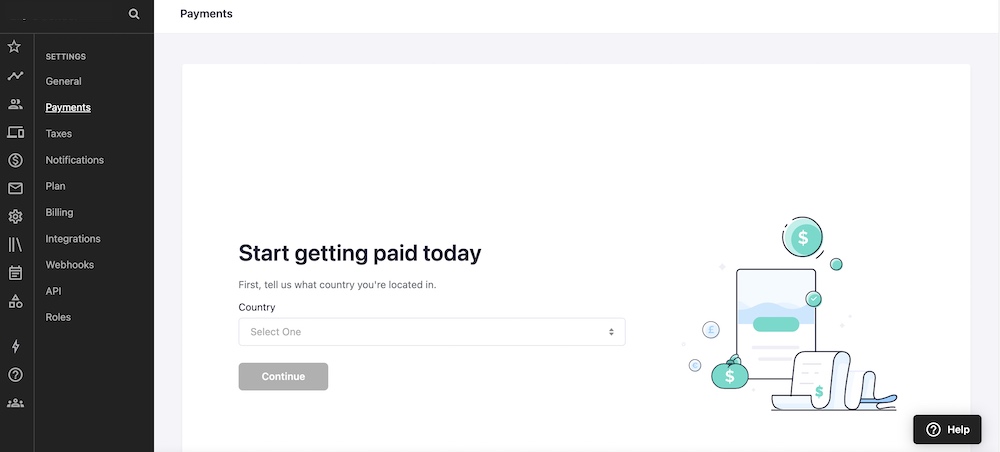If you're comparing Kajabi vs. Teachable, you're likely building an online education business looking to host, manage, and sell online courses, digital downloads, memberships, coaching, and more. Choosing the right platform can shape your growth, revenue, and ease of operations.
To help you decide, we’ve created this guide looking at Kajabi vs. Teachable. Which is the best value for your money? What are the differences between Kajabi vs. Teachable? Is one easier to use than the other?
We’ll answer these questions and highlight the most-used product features, pricing, and more to help you understand and decide which platform is right for your online business.
What’s the difference between Kajabi vs. Teachable?
Kajabi and Teachable are both platforms that help creators sell online courses and other digital products. But in 2025, the differences between them go beyond surface-level features—they impact how much control, profit, and scalability you really get.
Teachable
Teachable helps you easily create online courses, digital downloads, memberships, and coaching services.
Creators and business owners want tools that don’t limit how they build and run their businesses. Tools that try to solve all of your needs in one platform can be limiting. Unlike Kajabi and other all-in-one platforms, Teachable focuses on giving you more control and options, so you can build your business your way. Overall, it’s a user-friendly platform for all types of creators─no design or coding experience necessary.
Here’s what sets Teachable apart:
- Public API and custom integrations to scale and automate with your tools
- Flexible pricing tiers starting at $29/month with unlimited students, courses, and 0% transaction fees (on Builder and up)
- Teachable Payments: Global tax remittance, 130+ currencies, affiliate/referral automation, and instant payouts
- Advanced monetization tools: Upsells, bundles, order bumps, memberships, and affiliate payouts—built in
Whether you’re tech-savvy or non-technical, Teachable is a no-code, no-limits platform that unlocks more potential at every level—without added costs.
Teachable is one of the most affordable and flexible platforms on the market. It has the best-in-class student experience and is designed to grow with your business. If you’re just starting your knowledge business, it has everything you need. As your business grows, you can use the Teachable API to customize and connect with other platforms to fit your needs.
Kajabi
Kajabi markets itself as an all-in-one solution for online course business owners. In addition to creating online courses, Kajabi also includes features like a website builder, email marketing, webinars, sales funnels, and more.
A few things to know:
- Product caps: Kajabi limits how many products you can sell—even on higher plans (e.g., 15 total products on Growth at $199/month)
- No public API: You can’t deeply integrate or automate beyond approved third-party apps like Zapier
- No affiliate payouts or student referrals: You’ll need to handle those manually with third-party tools
- Limited tax tools: Kajabi doesn’t automate tax remittance or 1099s, so international and affiliate payouts get messy
- Premium pricing: Kajabi’s lowest plan starts at $119/month with no free option—and lacks many of Teachable’s built-in features
Because Kajabi seeks to fill many technology-related needs of online business owners, it tends to fall short in course-related functions. For example, it doesn’t offer course compliance controls like course completion certificates. Kajabi’s analytics reports, payout management functions, and tax tools have fewer features than Teachable.
Kajabi doesn’t have a complete API. It has integrations, often marketed as API. For instance, you can integrate third-party apps with Zapier. However, these integrations do not allow for the customization and creativity you may need.
Kajabi’s high price point makes it a less accessible and affordable platform for beginner course creators. If you’re just getting started with online course sales, terms like “pipelines” and “sales funnels” might be a little intimidating.
In addition to its premium pricing, Kajabi also limits the number of courses and products a creator can offer in their school, making it difficult to grow without added costs.
Kajabi vs. Teachable product features
Now that we’ve done a high-level overview of each platform, let’s dive into specific product features and compare how each platform stacks up.
In this section, we’ll compare the following product features and benefits in more depth:
- Course creation
- Student management
- Course marketing and monetization
- Managing payments and finances
- Business scalability
- Support and community resources
Creating online courses
Both Kajabi and Teachable make it easy for entrepreneurs to create online courses. However, the dashboards are slightly different on Teachable vs. Kajabi.
Teachable
In Teachable, users can create and sell various products–courses, coaching, digital downloads, or bundles. You can create a “new course” and add content to the course builder with just one click.
Teachable uses a series of content blocks or sections to organize course curriculums. Inside each section, you create lessons that include content like video, files, text, quizzes, and feedback forms. Once you add your content, you can also use the “drip” function to publish lesson sections on specific dates.
Inside the individual course dashboard, you can easily create course pages (sales page, checkout page, thank you page). Then, add pricing and design the look and feel of your course home page. With Teachable’s Power Editor tool, you can also make advanced modifications to customize the layout and style of lessons, sales pages, checkout pages, and more.
Last, you can use “bundles” to easily group courses, coaching, and downloads together to sell for a single price. In short, Teachable’s dashboard lets you create and manage your course content, pricing, and pages in one easy-to-use space.

Kajabi
In Kajabi, users can create five different types of products: mini-courses, online courses, evergreen training, communities, and memberships.
Kajabi segments its course products into three different categories. You must first choose whether to create a short, one-category course (mini-course), a longer course (online course), or a course with dripped contents (evergreen training). Whereas in Teachable, users can create each of these course types under the single “course” umbrella.
Once you select the course type, you can add content into categories and subcategories. However, unlike Teachable, you can only add two types of content formats—videos and assessments (quizzes). To add text, you must create a “post.”
One main difference between Kajabi and Teachable is the course pricing tool. In Kajabi, you can’t add pricing or create course pages inside the course builder. You must navigate to “offers” and “landing pages” to link these elements. Additionally, if you want to sell more than one product together, you will need to bundle them with the offer feature.
Managing and enhancing the student experience
To generate raving reviews and keep students coming back for more, you need to create an excellent student experience. Here’s how Teachable and Kajabi’s student management features stack up.
Teachable
Several administrative tools help Teachable creators manage their student experience.
In the course “reports” section, you can view comprehensive student dashboards. These dashboards include reports on:
- Lesson completion rates
- Quiz results
- Student leaderboards
- Video engagement
You can utilize student progress reports to track how individual students are progressing and performing.
One notable feature that sets Teachable apart from Kajabi is course compliance. With course compliance controls, you can set requirements for completing lesson content in a course. Upon completing the required content, you can issue students a course completion certificate.
Teachable has several built-in administrative functions to help you manage things like student information, enrollments, and transactions. But, you also have more flexibility than other platforms.
For advanced integrations and customization, you can use Teachable’s public API. Working with a developer, you can connect your business data across platforms. You can also automate workflows or build custom apps.

Together, these features help you stay compliant, increase course credibility, and build a better online course reputation.
To summarize, Teachable has several features and products that help creators build a reputable and interactive online student experience.
Kajabi
Like Teachable, Kajabi has student administrative functions, memberships, and coaching. However, there are a few big differences between Kajabi and Teachable.
Kajabi has native member management functions that help users manage subscriptions, student progress, and payments. Course creators can also administer course assessments like quizzes and surveys. However, unlike Teachable, Kajabi users need to use a workaround to send course completion certificates to students.
It also offers a membership and coaching product. Just like Teachable, the membership product on Kajabi provides subscribers with evolving, on-demand content. However, memberships and coaching in Kajabi require additional, advanced setup steps.
Marketing and selling your course
Once you’ve created the contents of your digital product, it’s time to market and sell it. There are a variety of course monetization tools available on both Teachable and Kajabi.
Teachable
You’ve plugged in all your lessons, added engaging videos, designed a beautiful sales page, and now you are ready to sell. This is where Teachable shines.
Teachable’s affiliate marketing and student referral tools make getting the word out about your course easy. Incentivize existing students to refer your digital product to friends to earn discounts. Even better, enlist the help of other influential creators as affiliates to promote your products. Offer affiliates a percentage of revenue from any sale resulting from their promotional efforts.
Another great monetization tool in Teachable is “order bumps.” Order bumps add additional product(s) to the checkout page so students can purchase complementary products with a single click. Creators can increase their overall revenue with upsell offers.
Although Teachable doesn’t have a complete email marketing tool, you can send emails to students directly on the platform. The platform also integrates with several third-party email providers and analytics tools to streamline your online business marketing.
Thanks to Teachable’s public API, you can also connect it to any analytics dashboard you want. Whether it’s Google Analytics, Facebook, or something else, it’s up to you.
Kajabi
Kajabi is marketed as an all-in-one business tool, specifically when it comes to marketing and selling your digital products. Kajabi includes marketing features like a dedicated email marketing tool, live webinars, upsells, and affiliate marketing. However, it’s important to note a few critical caveats about the capabilities of these marketing tools.
Although embedded directly on the platform, Kajabi’s email marketing tool doesn’t include some advanced features that are found on traditional email marketing platforms like MailChimp. Similarly, the webinar feature is basic and does not offer the same customization and segmentation options available on platforms like WebinarJam.
In Kajabi, users can create an upsell offer. However, users must navigate to the “offers” section and individually link a new offer to the desired course.
Like Teachable, Kajabi includes an affiliate portal for creators who want to partner with others to promote their courses. You can view affiliate users and transactions within the portal and send affiliate announcements.
However, you have to manage payouts yourself. Kajabi also does not have a separate student referrals program.
Although Kajabi provides several marketing tools, some tools may lack certain functionality as you continue to grow and scale your business. Because Kajabi doesn’t have a public API, you can only integrate with a few tools.
For example, it integrates with Google Analytics. However, it doesn’t directly integrate with Facebook Analytics.
Managing payments and business finances
With Teachable’s Payment Gateway and BackOffice feature, you can easily get paid, and manage payouts, business finances, and day-to-day operations.
Teachable
In Teachable, you have access to a number of back-office functions that can help you manage your finances, and assess how your online business is performing. In the “sales” tab, you can view sales transactions, monthly statements, daily and monthly earnings, and upsell performance.
Teachable Payments gateway can automate and easily manage payouts for yourself and your team. It also collects and remits the correct sales taxes in multiple marketplaces—US, EU, and globally. No other course platform, including Kajabi, has payment and monetization features like it.

With Teachable you can:
- Get paid daily, weekly, or monthly with payment sent directly to your bank account
- Accept payments using Stripe, PayPal, Mobile Pay, Google Pay, Apple Pay, and more
- Sell in over 130 currencies easily with the payments gateway
- Remit sales tax, handle VAT, and common tax forms automatically
Overall, Teachable makes it simple to get paid with flexible payment options and affiliate payout management. Kajabi has none of these advanced payment and tax capabilities.
Kajabi
Kajabi has some back-office functions that make it easier for users to manage their internal business operations. However, it doesn’t have nearly as much functionality, especially when it comes to payments and taxes.
Kajabi users can track sales data like revenue, membership site subscriptions, and website page performance.
It falls short with affiliate payouts, payment options, and taxes. The platform does not handle affiliate payouts for its users. Users are responsible for paying their affiliates via a third-party payment portal. It doesn’t manage anything with taxes either.
Growing your business
As your business grows, your needs may change. If you want to expand your business from courses to other digital products, you’ll need a platform that scales with you.
Teachable
In addition to online courses, Teachable users can create digital downloads, coaching products, and memberships. Coaching and downloads are built into Teachable’s platform.
Creating and selling a variety of digital products can scale your business and increase revenue. For example, creating and uploading digital downloads can generate passive income. With Teachable coaching, you can schedule interactive coaching sessions and nurture deeper student relationships. Similarly, memberships are a recurring revenue stream that can grow into a loyal community.
Kajabi
You can create different types of digital products with Kajabi. Its main focuses are courses and coaching. You’ll also want to consider how many products you want to offer. Kajabi’s pricing doesn’t break down products by type (coaching, courses, downloads, etc.)
Instead, it counts them as one product, which can limit your revenue. For example, Growth, Kajabi’s most popular paid plan, costs $159/per month billed annually or $199/monthly. It’s more expensive than Teachable, and you can only sell 15 products. That total includes everything—digital downloads, coaching, courses, and other products.
Getting support and building community
Both Kajabi and Teachable give users access to resources like support articles, resource downloads, blogs, and product support. However, Teachable is the best Kajabi alternative, if you want a platform with more dedicated support to grow your business.
Teachable
All users—including free—have access to numerous support resources in Teachable’s Knowledge Base. This library of documentation and guidance helps users learn the basics of running a school through Teachable, manage behind-the-scenes details, and troubleshoot school issues.
Another feature is teachable:u, an online school for creators to learn how to make and sell courses, coaching, and more.
Kajabi
All Kajabi users have access to weekly webinars, product support, and the Kajabi University. Like Teachable, these resources enhance the user experience with the product. Specifically, the Kajabi University includes guided content on all Kajabi products and features—just like Teachable’s Knowledge Base.
Kajabi also offers its users access to the Kajabi Community. This community is hosted on Facebook and gives users access to real-time advice and guidance from other Kajabi users.
Both Kajabi and Teachable offer extensive documentation, guidance, and community support for users. However, it’s important to note that not all features, like 24/7 chat support in Kajabi, are available on all paid plans. For example, if you want help onboarding, it’s a $90 extra charge.
Kajabi vs.Teachable: Pricing plans
Running an online business can be costly. From software subscriptions to monthly business expenses, out-of-pocket costs can add up. So, you might be wondering, “which online course platform will help me sell my online course with the least fees and most profit?”
Both Kajabi and Teachable offer multiple pricing plans to fit the varying needs of course creators.
Teachable offers more affordable pricing options than Kajabi. Unlike Kajabi, Teachable also provides a free trial for creators. Similarly, all Teachable paid plans are unlimited. There is no limit to the number of students or courses in your school–meaning there is no limit to the revenue you can produce.
Let’s take a closer look at Kajabi vs. Teachable pricing.
Starting your online business journey with Teachable
Today, millions of people are turning to online education to gain new skills in an affordable, self-paced environment.
Take the next steps with your online education business today by starting a free account in Teachable—no credit card or commitment required. Start building your course, brand, and business in minutes with our stress-free, easy-to-use platform.
Interested in learning how other successful creators bring their courses to life with Teachable? Click here to view examples of thriving knowledge businesses in areas like art, health, academics, and more.
{{pricing-component="/blog-shortcodes/blog-cta"}}
Join more than 150,000 creators who use Teachable to make a real impact and earn a real income.


.png)




